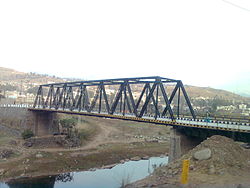Pir Panjal Region
Pir Panjal | |
|---|---|
Region | |
 Bridge in Rajouri | |
| Administering Country | |
| Union Territory | Jammu and Kashmir |
| Area | |
| • Land | 4,304 km2 (1,662 sq mi) |
| Population (2011)[1] | |
| • Total | 1,119,250 |
| Districts | |
The Pir Panjal, is a region located south west of Pir Panjal Mountain Range. The region is located in Jammu Division in Jammu and Kashmir, India.[2][3]
Name[]
The Pir Panjal range is named after the Pir Panjal Pass, whose original name as recorded by Srivara, is Panchaladeva (IAST: Pāñcāladeva, meaning the deity of Panchala). Panchala is a country mentioned in the Mahabharata in the northwest Uttar Pradesh. However, there are also traditions that place the Mahabharata regions in western Punjab and southern Kashmir. Scholar Dineshchandra Sircar has analysed the geography described in the Shakti‐sangama Tantra, where this is indeed the case.Scholar M. A. Stein believes that the concept of deity must have been translated into that of a Pir after the region was Islamised.[citation needed]
Geography[]
The Pir Panjal Region includes the districts of Poonch and Rajouri. The region touches Kashmir Valley to North & East, Azad Kashmir to West and Jammu Division to East.
Demographics[]
Pir Panjal region: mother-tongue of population, according to the 2011 Census.[4]
Tourism[]
Pir Panjal is also the hub of hilly tourist attractions after Valley of Kashmir & Chenab Valley, some of them are as follows;
- Pir Ki Gali
- Shrine of Sayin Miran Baksh
- Shrine of Baba Ghulams Shah Badshah(Shahdara Sharief)
- Chingus Sarai
- Noori Chambh
- Loran Valley
- Budha Amarnath
- Poonch Fort
- Historic Mughal Road
Demand For Divisional Status[]
There has been a movement demanding divisional for the Pir Panjal by various social and political activists for a long time. The demand rose in 2018 and 2019 when Ladakh got divisional status and the former Chief Minister of Jammu and Kashmir, Omar Abdullah added "Two Separate Divisional Status for Chenab Valley and Pir Panjal Region" to his party's political agenda.[6]
As of 2021, the movement for of divisional status or merger with Kashmir Division again increased after rumours of second bifurcation of J&K and demand for a separate state of Jammu.The majority of people in Pir Panjal are ethnic Paharis & Gujjars and are more connected to their Kashmir Valley breathen by religion, culture, connectivity, geography & historical links with Kashmir.
There is a common reason for this demand. People allege negligence in terms of developmental issues by the government if the Pir Panjal remains linked to the Jammu division.[1]
Hill Development Council[]
In 1996, Dr. Farooq Abdullah as Chief minister promised administrative autonomy to Chenab & Pir Panjal.[7]
References[]
- ^ a b Ayoob, Anzer (17 July 2021). "J&K: Chenab Valley Seeks Separate Divisional Status as well as Council". NewsClick.in. Retrieved 20 July 2021.
- ^ "Geelani vows to resist settlement of retired soldiers in Kashmir". Archived from the original on 3 October 2015. Retrieved 30 September 2015.
- ^ "THROUGH THE PIR PANJAL".
- ^ a b C-16 Population By Mother Tongue – Jammu & Kashmir (Report). Office of the Registrar General & Census Commissioner, India. Retrieved 18 July 2020.
- ^ "Population by religion community – 2011". Census of India, 2011. The Registrar General & Census Commissioner, India. Archived from the original on 25 August 2015.
- ^ "Separate division for Ladakh: Omar promises two more for Chenab valley, Pir Panjal if voted to power". Times of India. 8 February 2019. Retrieved 31 July 2021.
- ^ "Why oppose Hill Council status for Chenab, Pir Panjal valleys?". Brighter Kashmir. 25 March 2020. Retrieved 8 August 2021.
- Geography of Jammu and Kashmir